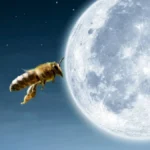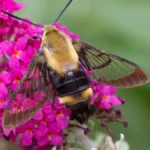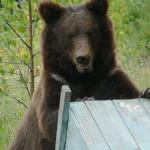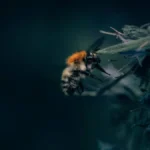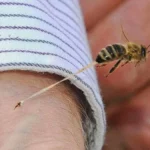Bees are insects and insects are food to many animals. Bees also store honey, and a beehive contains a lot of brood. When we ask what eats bees in the food chain, there is quite a long list of animals. In this article, we will have a look at what eats bees and have a look at some major honey bee predators.
Eating Bees
Bees are a bit like mushrooms. You can eat any mushroom once – but an expert can eat the right mushrooms and live to do it again.
If we look at a bee – it has orange stripes on it. The end of the bee has a sting and that sting is there to teach lessons. Most animals will eat a bee once by mistake – in some cases, this will kill the animal, in other cases, it will teach the animal a lesson. Animals who have learned this lesson treat bees with respect.
Animals That Eat Bees By Accident
I once saw a young dove that was eating chicken food that I had sprinkled outside peck at a bee. A few seconds later it fell over dead. Clearly, it had no idea what it was eating, and it never learned a lesson. It just died.
Sometimes at night, you will find funny things in front of beehives. I have seen toads eating bees. Once I found a dead toad in front of the hive, so clearly this can go wrong for them. I have seen a red-eared slider terrapin sitting at the landing board of a small hive in the evening. As the guards came up to the terrapin it snapped them in half and ate them.
We often find rodents moving into hives – if the hive is weak in winter the small animals are attracted to the warmth of the bees and the shelter the hive offers. Every now and then they will nibble at a dead bee and eat some honey if they can.
Animals That Eat Bees On Purpose
To eat a bee on purpose, you have to be clever, thick-skinned, or both.
Clever Creatures That Eat Bees
Birds
Clever birds like magpies can learn how to catch bees and scrape them on a branch to remove the sting. Other birds such as kingfishers, mockingbirds, thrushes, martins, swifts, and swallows may eat a bee here and there. In some cases, these birds can locate Drone Congregation Areas and will eat drones, which are a good-sized meal and don’t have stings. There is a pun in there somewhere – if a swallow swallows a drone which is basically a big flying ball of male gametes.
In Africa and Asia drongo birds are highly intelligent birds that will literally hawk a bee on the wing. After catching the bee, they wipe the sting out of the bee on a tree branch and then eat the bee. A single bird can eat 50-100 bees in a day.
The famous honeyguides. The lesser and greater honeyguide are both birds who make a living out of eating bees and comb. The greater honeyguide will even guide a human, honey badger, or baboon to a beehive and encourage them to rob the hive. It is customary to leave a bit of brood comb for the honeyguide as a thank you.
The lesser honeyguide will not normally guide anything to a beehive, but it will be found near the hive, hawking bees, and if anything robs the hive, it will shoot in and eat any brood and honey it can. These birds are parasites and parasitize birds such as the Black Collared Barbet.
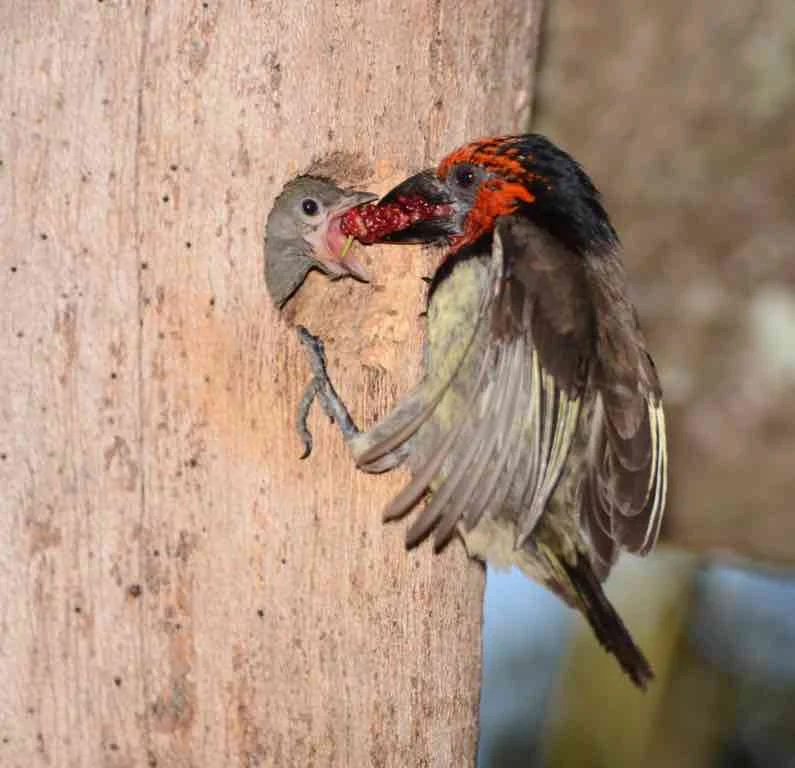
Insects and Spiders
Many different insects and spiders will eat bees. Yellowjackets can damage hives. Praying mantids will eat bees on flowers, as will certain spiders. Sometimes bees can get caught in spider webs, with golden orb spiders being particularly talented at hunting bees this way.

Animals
Bears, humans, honeybadgers, and baboons are the most common animals in this list that will rob beehives. Various other smaller mammals can rob hives as well, but most do not make a habit of doing this.
As far as honeybee predators go, the human is by far the worst. We have a history of raiding beehives and this history dates back hundreds of thousands of years.
Baboons are pretty funny to watch when they raid bees. A baboon is an inherently comical animal. It basically behaves like a drunk high school hooligan. When baboons raid beehives you must remember they have a big pink exposed bum. Typically, what happens is the first baboon will run to the hive and rip the lid off and then they all go and sit in the distance watching.
Once the bees settle down the next baboon will run along and quickly grab in the hive and rip out a few frames or combs and throw them in the trees near the hive. Then it runs at great speed squealing and making a commotion as its exposed pink butt gets stung.
A bit of time elapses and the baboons dash in and remove the combs in the trees and then sit eating them. A while later the cycle repeats and eventually, your entire apiary is destroyed. If you find a group of baboons who have been robbing hives you will note they do not sit on their bums for a day or two.
Modern Predators Of Beehives
As we become a more and more dominant species we are covering our planet with human technology. There are two major predators that we have introduced to the world, and these predators can really damage beehives.
Bright Lights
I used to live next to a private school. This school had a lot of money, and one year they build a complex of astroturf sports fields, complete with tall floodlights to allow sports practice at night. I had twenty hives in my backyard, and the bees did exceptionally well in this neighborhood. In a dry year, I would average 50 pounds a hive. In a wet year about 80 pounds a hive.
Then the floodlights came. At night, you could watch the bees leave the hives and fly to the lights where they would mill around until they ran out of energy. From the point the lights arrived, my production in that apiary went from 50-80 pounds, to under 10 pounds. The hives just never got strong. The lights ate the bees.
Spotlights, security lights, street lights, and all human light pollution destroys bees.
Insect Traps
These consist of a UV tube and a high voltage grid that electrocutes bees. Bees are attracted to UV light. Insect traps can kill thousands of bees a night. In some cases this can cause fires – if too many bees pile up below the trap, the trap will arc onto the heap of bees and set them alight, causing the insect trap to catch alight, and this can cause the building it is attached to catch alight. Or it will destroy the trap.
Highways
I have seen apiaries placed near highways that worked on trees. The one year, a farmer planted canola on the other side of the highway – and most of the hives died. Speeding vehicles would kill thousands of worker bees per hour. The beekeeper blamed pesticides, but when I showed him the tarmac, and we looked on the side of the road there were millions of dead bees.
We hope this has helped you understand what eats bees in the food chain. Honey bee predators are as you can see, mainly us and our technology. Please share this to help your friends understand why lights are bad for bees.
Read more about: Small Hive Beetle Larvae Vs Wax Moth Larvae

Dr. Garth A. Cambray is a Canadian/South African entrepreneur and beekeeper with 28 years of experience in apiculture and specializes in adding value to honey. His Ph.D. research developed a new advanced continuous fermentation method for making mead that has resulted in a number of companies globally being able to access markets for mead. His company, Makana Meadery, exports honey mead to the USA where it is available to discerning connoisseurs. He has also developed technologies to commercially manufacture organic honey vinegar in Zambia for export globally. He holds a few patents globally in the ethanol industry and believes in technology and knowledge transfer for human development and environmental sustainability. One of his proudest achievements is the fact that the wind farm he started at one of his old apiary sites has essentially made his hometown carbon neutral.

